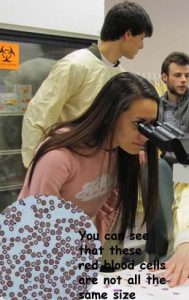Ron Hines DVM PhD
 See What Normal Blood & Urine Values Are
See What Normal Blood & Urine Values Are
 Causes Of Most Abnormal Blood & Urine Tests
Causes Of Most Abnormal Blood & Urine Tests
Red Blood Cell Distribution Width = RDW, RCDW
Your pet’s red blood cells (=erythrocytes= RBCs) should be very uniform in size. Red blood cells or RBCs make up ~25% of all the cells in the body. I have seen it written that the average dog produces and destroys about 800,000 RBCs every second; but I cannot confirm that that is true. Both dogs and cats have an enormous number of RBCs (adult humans have ~ 20–30 trillion). The average life span of a human RBC is 100-120 days. (read here)
Each red blood cell must be extremely small and uniform in size to pass through the small capillary blood vessels of your pet’s body without hindrance (getting stuck). One factor in determining RBC size is the number of cell divisions that occur between the red cell’s formation from stem cells in your dog or cat’s bone marrow and the time they leave the marrow mature. A protein, cyclin D3, is involved in that regulation.
In certain health issues, red blood cells may not be as uniform in size as they should be. Veterinarians use a mathematically calculated value, the RDW, to know when that is occurring. The actual measurement is of the volume or size of your pet’s red blood cells or its MCV. A high RDW means that there is too much variation in the size of your pet’s red blood cells.
Knowing that is occurring gives your veterinarian hints as to the possible cause of a confirmed anemia. The same problem will also be picked up as anisocytosis (RBC size variation) being noted in your pet’s CBC/ WBC lab results.
Why Your Cat or Dog’s RDW Might Be Higher Than Normal:
The RDW is not a stand-alone test. I do not put much faith in its ability to differentiate one cause of anemia from another. But it does add a bit of evidence – if the rest of your pet’s blood work agrees with what is generally accepted as the causes of abnormal RDW:MCV relationships.
When your pet has a vitamin B12 deficiency, as might occur with chronic intestinal problems like Inflammatory Bowel Disease, Its Red Blood Cell Distribution Width (RDW) will increase. The same thing can occur with a folic acid (folate) deficiency. In both cases, the MCV tends to be elevated as well. Traditionally, in those cases, anisocytosis is also noted by the central lab technician viewing your dog or cat’s blood slide microscopically and jotted down in the pet’s CBC/ WBC results. Some of the larger national labs now have machine algorithms that allow those sorts of visual notes to be added automatically.
High RDW can also occur with iron deficiency anemia. In those cases, the MCV is often low.
Recent hemorrhage or blood loss will often elevate RDW, but MCV usually remains normal.
Fragmentation (turbulence) anemia or any anemia in which the RBCs are destroyed while in the pet’s circulation (a hemolytic anemia) can cause RDW to be high and MCV to be low.
In humans, high RDW is sometimes associated with liver disease. We do not know if that is the case in dogs and cats.
A combination of several causes can also be responsible for an elevated RDW in your dog or cat.
DxMe
You are on the Vetspace animal health website
Visiting the products that you see displayed on this website help pay the cost of keeping these articles on the Internet.


